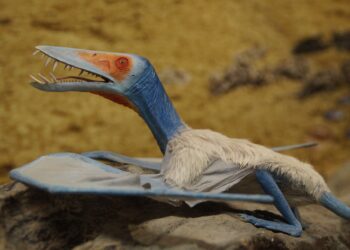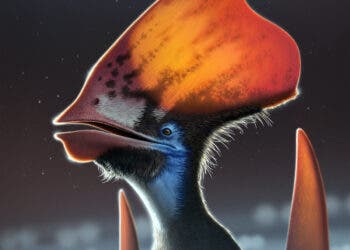
In 2013, police raided a storehouse at Santos Harbour in São Paulo where they found a huge stash of fossils belonging to more than 3,000 specimens. Inside one of the many limestone slabs, researchers in Brazil found the most complete fossils ever seen of an eccentric species of pterosaur that flew the sky during the Early Cretaceous. The nearly complete skeleton helps fill in the gaps in our knowledge about this elusive flying reptile.
The specimen retrieved from the police raid was sent, along with thousands of other fossils, to the University of São Paulo, where they fell under the watchful eye of vertebrate paleontologist Victor Beccari, then only an undergraduate student.
“The fossil gave me this emotion of awe when I first saw it, and at times I felt like I was way over my head with such an exceptionally preserved specimen,” Beccari told ZME Science.
The fossils belong to Tupandactylus navigans, a pterosaur known for its elaborate and colorful head crests. Although many taperjarids have been found across Brazil before, the vast majority of these fossils only preserved the skull. The newly described specimen, however, is almost fully intact, including most of the skeleton and remnants of soft tissue alongside the bones.
Beccari and colleagues performed CT scans of the specimen, allowing them to build an accurate 3D model of the pterosaur that, on the surface, was heavily obscured by sediment. This not only revealed the morphological features of the pterosaur without disturbing the fossils themselves but also allowed the paleontologist to continue work on the specimen while Beccari left for a master’s in Lisbon, Portugal.
The exquisitely preserved fossils, which originally come from the Crato Formation in Chapada do Araripe, Northeastern Brazil, reveal new stunning details about how this up-until-now mysterious subgroup of flying reptiles looked and foraged during the Cretaceous.
One of their most striking features was their long neck (over 50% of the axial skeleton length) and weirdly proportionate limbs. Together with the huge cranial crest that could grow over 40 cm (15 inches) tall, Beccari and colleagues believe the animal may have had difficulties performing long-distance flights.
These findings suggest that T. navigans likely employed a terrestrial foraging lifestyle. However, the specimen preserves all the adaptations to power flight, and would be able to use it to escape predators and possibly for short distance flights (such as for peacocks). The fossils also suggest that T. navigans and another pterosaur from Brazil, Tupandactylus imperator, may represent a single species.
“Right now we cannot be certain, but new specimens preserving the post-cranium of T. imperator could solve this issue. We also managed to compare this specimen with another fossil that was published in 2006, which showed us that this fossil would represent a post-cranial material of Tupandactylus,” Beccari said.
Next, the paleontologists from Brazil plan to further tackle the ecomorphology of these tapejarids, including what they ate and how they lived. “To do so, we’ll use the 3D data from this work in biomechanical studies to understand more about the stress in the skull bones and bite force of this animal,” Beccari added.
The study was published today in the journal PLOS ONE.






